
I’ll be honest—I never gave much thought to what happened to my bath mats after they’d served their time. For years, I’d simply toss them in the trash when they got worn out, thinking that was just what you did. But after going through three bath mats in two years (thanks to a particularly enthusiastic dog who loved post-bath zoomies), I started wondering if there was a better way. That’s when I discovered that yes, you absolutely can recycle bath mats, and there are several surprisingly easy options I wish I’d known about sooner.
If you’re standing in your bathroom right now, looking at a threadbare mat and wondering whether it’s destined for the landfill, you’re in the right place. I’ve spent the last year figuring out exactly what to do with old bath mats, from recycling and donation to choosing more sustainable options from the start. Let me share what I’ve learned.
Understanding What Your Bath Mat Is Actually Made Of
Before I could figure out how to responsibly dispose of my old bath mats, I had to understand what they were made of. Turns out, not all bath mats are created equal, and the material makes all the difference when it comes to recycling or donating.
Most bath mats fall into a few main categories. The classic cotton bath mat is probably what your grandmother had—thick, absorbent, and often with a rubber backing to keep it from sliding around. I’ve owned several of these over the years, and while they’re great for soaking up water, that rubber backing becomes a problem later (more on that in a minute).
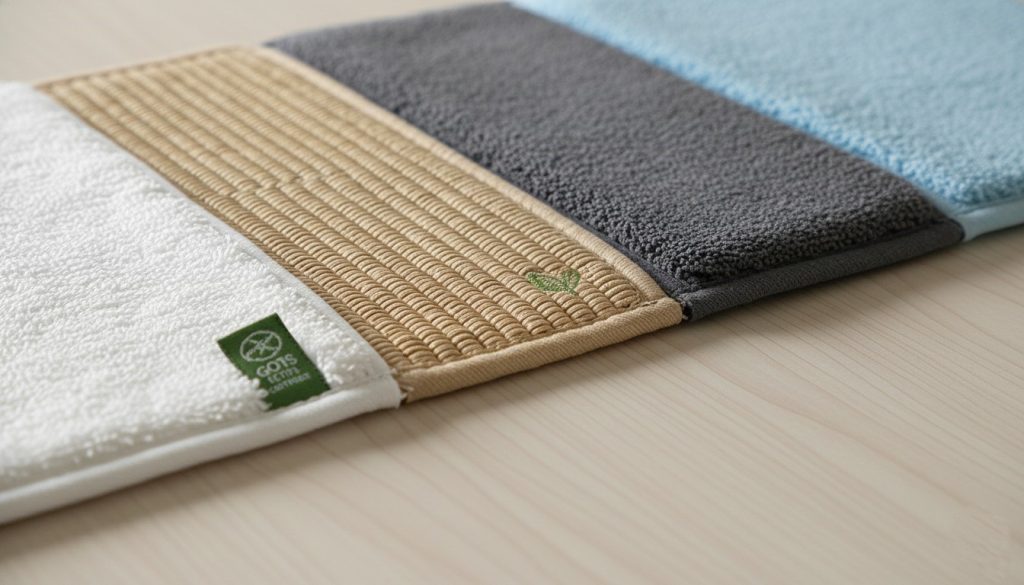
Then there are the newer materials. Bamboo mats have become popular lately, and I switched to one last year. They’re naturally antimicrobial, which means less of that musty smell that plagued my old cotton mats. Memory foam mats are incredibly comfortable underfoot—like standing on a cloud when you step out of the shower—but they’re typically covered in microfiber and have a synthetic base. And finally, there are fully synthetic mats made from polyester or other petroleum-based materials.
Why does this matter? Because when I called my local recycling center to ask if they’d take my old mat, the first question they asked was “What’s it made of?” A 100% cotton mat has recycling options that a rubber-backed one doesn’t. Understanding your mat’s composition is the crucial first step in keeping it out of the landfill.
Can You Recycle Bath Mats? Here’s What I Discovered
This was the big question I needed answered: Can you recycle bath mats at all? The short answer is yes, but it’s complicated. The longer answer depends entirely on what your mat is made of and what resources are available in your area.
When I first started investigating, I was optimistic. I separated my mats by type and did some research. My 100% cotton mat without backing? That one had several recycling options. Many communities have textile recycling programs specifically for natural fiber materials. I found a textile recycling bin at my local H&M store—yes, the clothing retailer—that accepts old textiles, including bath mats, towels, and linens. They partner with a recycling company that breaks down the fibers and repurposes them.
The rubber-backed mat was trickier. That rubber backing that prevents slipping in the bathroom becomes a nightmare for recycling facilities. Most standard textile recyclers won’t accept mats with rubber backing because they can’t easily separate the materials. I learned this the hard way when I brought one to a drop-off location and was politely turned away.
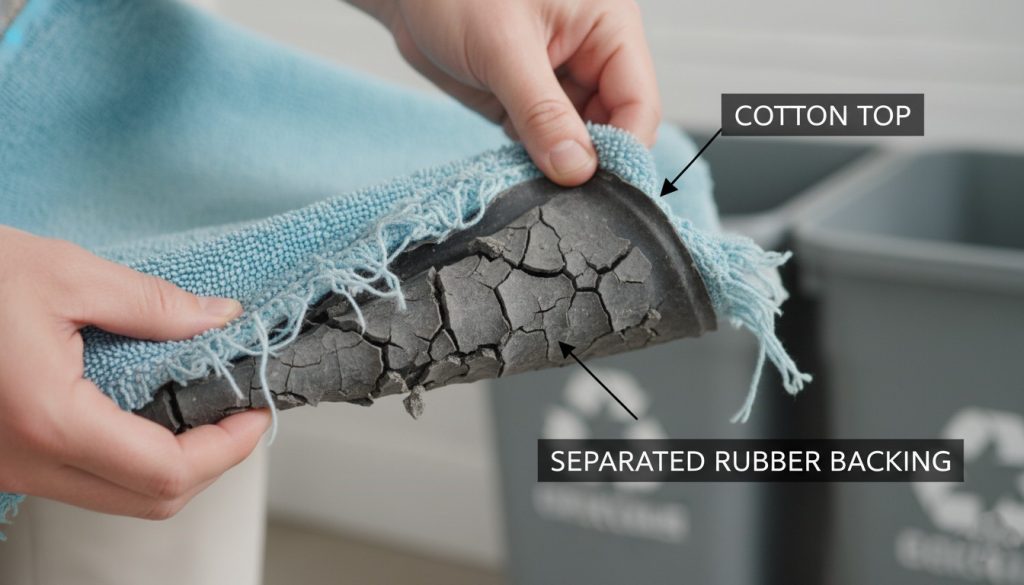
For synthetic and memory foam mats, the options are even more limited. These materials typically aren’t biodegradable, and specialized recycling programs for them are rare. I contacted three different recycling facilities in my area, and none accepted memory foam bath mats. One facility worker told me that unless you can find a program specifically for foam products, these usually end up in the landfill.
However, I did find some hope through TerraCycle, a company that runs specialty recycling programs. While they don’t have a specific bath mat program, they sometimes run limited programs for specific materials. It’s worth checking their website periodically to see if they’re accepting the type of mat you have.
The reality check here is that while recycling bath mats is possible, it’s not always convenient. But that doesn’t mean you’re out of options.
How to Recycle Old Bath Mats: My Step-by-Step Process
After sorting through all the information, I developed a system for recycling my old bath mats that actually works. Let me walk you through exactly what I do now.
First, I assess whether the mat is even worth recycling. If it’s still in decent shape—just a bit worn or faded—donation might be the better route. But if it’s genuinely at the end of its life (stained, thinning, or developing that permanent mildew smell despite washing), recycling is the way to go.
For cotton mats without rubber backing, the process is straightforward. I give them a final wash to remove any soap residue or dirt. Most textile recycling programs prefer clean materials, though they don’t need to be perfect. Then I locate my nearest textile drop-off. Besides H&M, I’ve found bins at some grocery stores, community centers, and the municipal recycling depot. I keep a list on my phone so I can drop off items when I’m already running errands in that area.
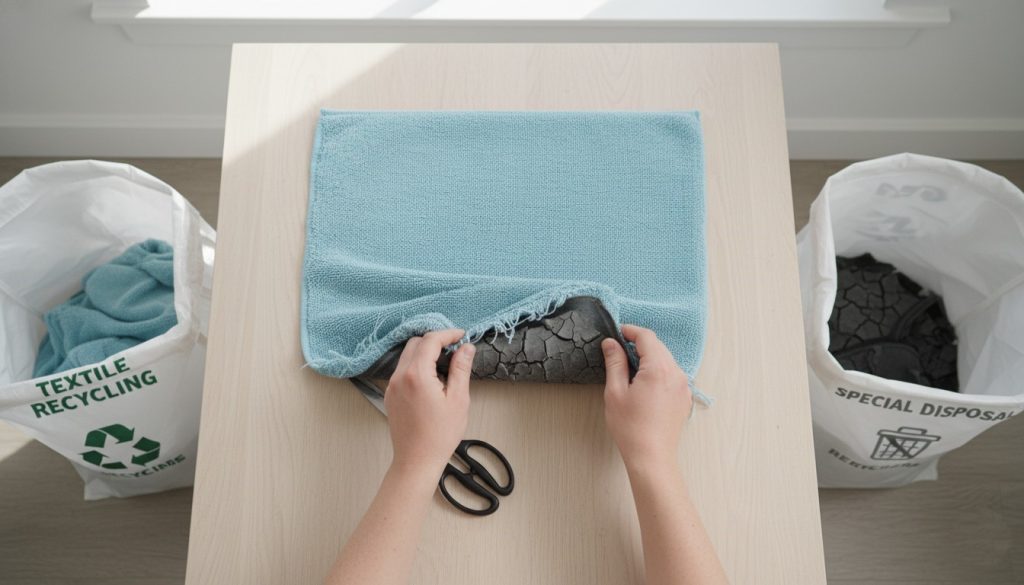
The rubber-backed mats require more effort, and honestly, this is where I’ve gotten creative out of necessity. Since most places won’t take them intact, I’ve learned to separate the layers. Using heavy-duty scissors (this is not a job for your fabric shears), I cut away the rubber backing from the textile layer. It takes about fifteen minutes per mat, and yes, it’s tedious. The cotton part can then go to textile recycling, while the rubber… well, that’s still a challenge. Some areas have programs that accept rubber products separately, but I haven’t found one locally yet.
For mats I genuinely can’t recycle through traditional means, I’ve embraced upcycling. My old cotton mats have become cleaning rags—cut into squares, they’re perfect for washing the car or cleaning up spills in the garage. I keep a stack in the utility closet and grab one whenever I need something disposable for a messy job. My dad uses old bath mat pieces as kneeling pads in his garden, and they work brilliantly for protecting his knees while weeding.
One of my favorite upcycling discoveries happened by accident. I gave an old mat to my sister, who has three dogs. She cut it into smaller pieces and placed them in her dogs’ crates. The dogs loved them, and she told me they were more absorbent than the expensive pet bedding she’d been buying. Now I save my worn bath mats specifically for her.
The key lesson I’ve learned is that recycling old bath mats takes a bit more effort than tossing them in the blue bin, but it’s absolutely doable once you understand your options.
How to Donate Old Bath Mats
Before you go through the effort of recycling, consider whether your bath mat still has some life left in it. I’ve donated several mats that I replaced simply because I wanted a new color or style, not because they were actually worn out. That’s when donation becomes the perfect solution.
The condition matters here. I use what I call the “guest test”—would I feel comfortable putting this mat down if a guest were using my bathroom? If the answer is yes, it’s good enough to donate. Small stains or slight fading are usually fine, but if it’s threadbare, permanently discolored, or smells musty even after washing, recycling or upcycling is the better choice.
Thrift stores like Goodwill and Salvation Army accept bath mats in good condition. I’ve donated to both, and neither has ever turned down a gently used mat. However, I learned to call ahead first because some locations have specific days when they accept home goods, and others have volume limits during busy seasons.
The real revelation for me came when I discovered that animal shelters are often desperate for bath mats. I volunteer occasionally at our local shelter, and they go through bath mats constantly—they use them in kennels, in washing areas, and even as bedding for nervous dogs. One shelter volunteer told me they can never have enough.
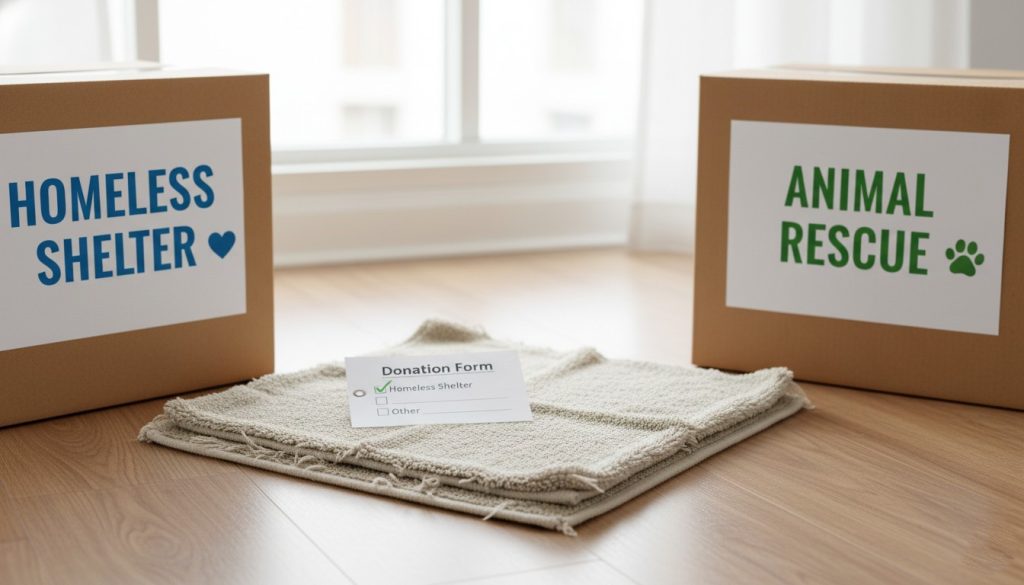
I called three animal shelters in my area, and all three enthusiastically accepted bath mat donations. They don’t care if the color is dated or if there’s a small stain. They just need absorbent, washable materials. Now, whenever I replace a bath mat, my first call is to the shelter. It feels good knowing that what I’m discarding is actually helping animals in need.
Homeless shelters are another option, though they tend to be more selective about conditions. The shelter coordinator I spoke with explained that they try to maintain dignity for their residents, so they prefer items that don’t look too worn. Still, a bath mat that’s too faded for your taste might be perfectly acceptable to them.
Community centers, churches, and organizations that help people transitioning out of homelessness or fleeing domestic situations often need basic home goods. These organizations might not advertise that they accept bath mats specifically, but when I’ve called and asked, they’ve always said yes.
Environmentally Friendly Options for Your Next Bath Mat
After going through this whole journey of figuring out how to dispose of my old bath mats responsibly, I decided to make smarter choices from the start. The most environmentally friendly mat is the one you don’t have to replace as often, so I started researching options that would last longer and be easier to recycle eventually.
I switched to organic cotton bath mats last year, and the difference is noticeable. Look for GOTS certification (Global Organic Textile Standard) when shopping. These mats are made without harmful pesticides, and because they’re 100% natural fiber without synthetic backing, they’ll be much easier to recycle when the time comes. I found mine at a local home goods store, and while they cost about $10 more than conventional options, they’ve held up better than any mat I’ve previously owned.
Bamboo was my next experiment, and I’m genuinely impressed. Bamboo grows incredibly fast without pesticides or much water, making it a sustainable crop. The bamboo mat in my guest bathroom is naturally antimicrobial, which means it stays fresher between washes. I’ve also noticed it dries faster than cotton, which has eliminated the musty smell that used to plague my bathroom. The one downside? Many bamboo mats still have synthetic backing, so check the label carefully.
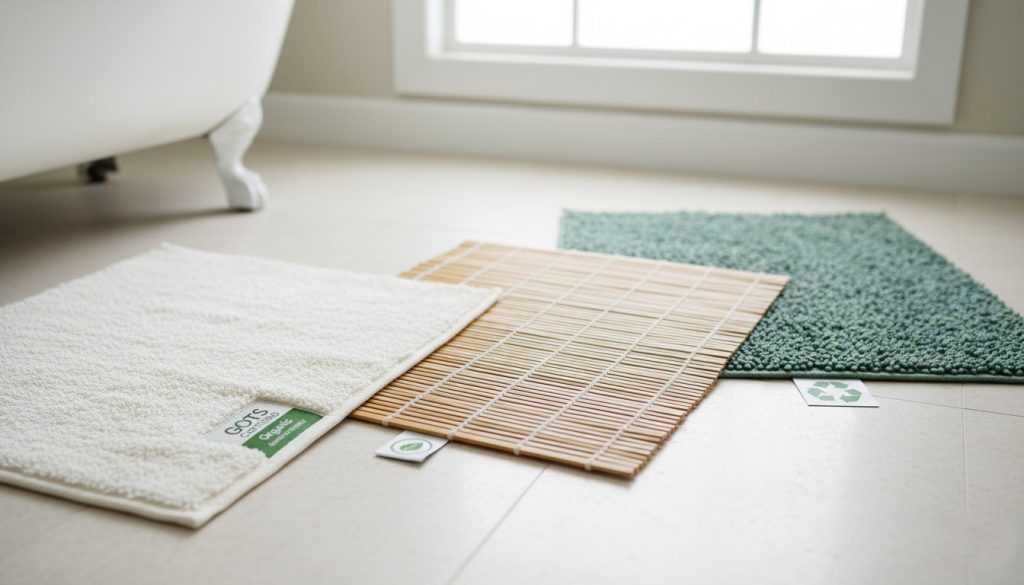
I’ve also seen bath mats made from recycled materials, though I haven’t personally tried one yet. These are typically made from recycled plastic bottles or reclaimed textile scraps. The concept appeals to me—supporting the recycling industry by buying products made from recycled content—but I’m still researching their durability and eventual recyclability.
One important lesson I learned: avoid rubber backing if you can. Natural rubber is better than synthetic, but both create recycling problems. I now use bath mats without any backing and rely on the bathroom’s textured floor to prevent slipping, or I add a separate non-slip pad underneath. This makes the mat itself much easier to wash and eventually recycle.
The price difference between conventional and eco-friendly options isn’t as dramatic as I expected. A basic bath mat might cost $15-20, while an organic cotton or bamboo alternative runs $25-35. But here’s the thing—I’ve replaced cheap mats twice in the time I’ve owned one good bamboo mat. The math actually works in favor of the sustainable option.
Taking care of your mat properly extends its life significantly. I wash mine in cold water every week (or more often if needed), skip the fabric softener which can reduce absorbency, and hang them to dry whenever possible. The dryer is hard on bath mats and shortens their lifespan. These simple steps have made my current mats last much longer than my old ones ever did.
Creative Ways to Reuse Bath Mats Before Recycling
Sometimes the best way to keep something out of the landfill is to use it differently before it reaches the end of its life. I’ve found several practical second uses for bath mats that have saved me money and reduced waste.
My garage floor now features old bath mat pieces under my tool bench. They’re perfect for catching oil drips when I’m working on the car, and when they get too dirty, I just toss them—guilt-free, because they’ve now served two purposes. The absorbent cotton soaks up spills better than anything else I’ve tried.
Last winter, I cut up an old memory foam mat and placed the pieces in my car’s footwells. They worked surprisingly well for trapping snow and salt during messy months. Come spring, I threw them away without feeling wasteful because they’d genuinely earned their keep.
For anyone with pets, old bath mats are incredibly useful. Besides the crate liners I mentioned earlier, I’ve placed them under food bowls to catch spills, used them as temporary bedding in carrier crates, and even put one in the trunk when transporting my dog to prevent her from sliding around. My neighbor uses old mats in her chicken coop for extra insulation during winter.
If you’re into gardening, bath mats have multiple applications. The cushioning makes them excellent kneeling pads—way more comfortable than kneeling on bare ground. I’ve also seen people cut them into strips and use them as temporary ground cover between garden rows to suppress weeds. As they break down (if they’re natural fiber), they add organic matter to the soil.
One unexpected reuse came from my friend who’s a teacher. She asked if she could have my old bath mats for her classroom. She uses them as quiet spots for kids to sit during reading time, and the cushioning makes the floor more comfortable. The school’s maintenance staff regularly washes them, and they’ve been in use for over a year now.
Making the Sustainable Choice Moving Forward
Looking back at my journey from thoughtlessly tossing bath mats in the trash to carefully considering their entire lifecycle, I’ve realized that small changes in how we think about everyday items can make a real difference. Bath mats might seem insignificant, but when you consider how many households replace them every year, the collective impact adds up quickly.
The most important lesson I’ve learned is to think ahead. Before buying a bath mat now, I ask myself: What happens to this when I’m done with it? Can it be recycled? Will it last? Is there a more sustainable option? These questions have completely changed my purchasing habits, not just for bath mats but for all household items.
I’ve also accepted that sometimes convenience and sustainability require balance. Yes, it would be easier to buy the cheapest bath mat at a big box store and throw it away when it wears out. But taking an extra fifteen minutes to research sustainable options, or spending a Saturday afternoon dropping off donations and recyclables, feels like a worthwhile investment in reducing my environmental footprint.
If you’re standing in your bathroom right now, wondering what to do with that worn-out bath mat, start with the simplest option that applies to your situation. Is it still usable? Donate it to a shelter. Is it made from natural fibers? Find a textile recycling program. Is it completely worn out? Get creative with upcycling before considering the trash as a last resort.
And when you’re ready to buy a new mat, choose wisely. Opt for natural materials, skip the rubber backing if possible, and invest in quality that will last. Your bathroom floor—and the planet—will thank you.
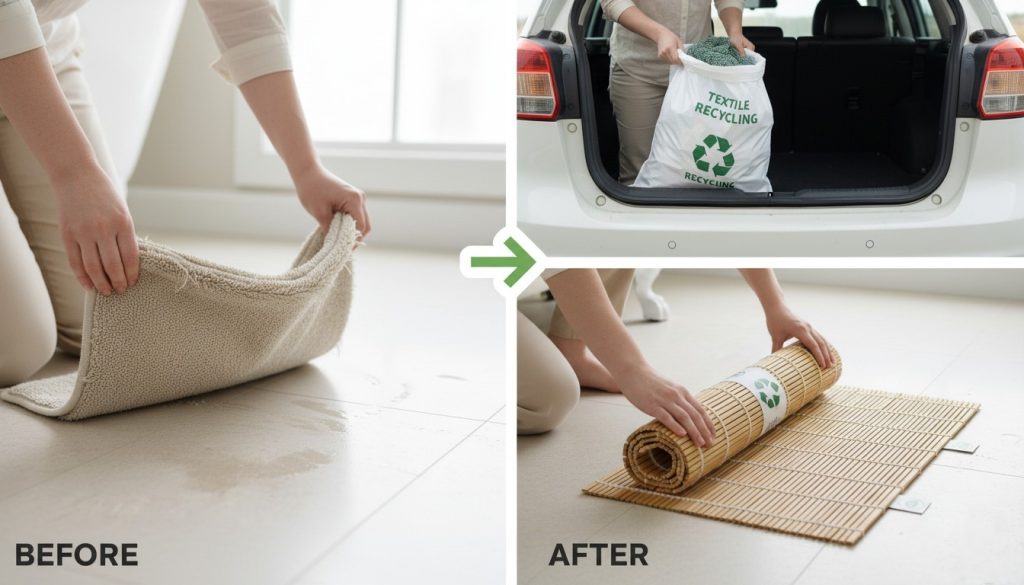
The reality is that we can’t always make perfect environmental choices, but we can make better ones. Understanding how to recycle, donate, and choose environmentally friendly options for something as simple as a bath mat is a step in the right direction. Every small action counts, and now you have the information you need to make those choices confidently.
Leave a Reply